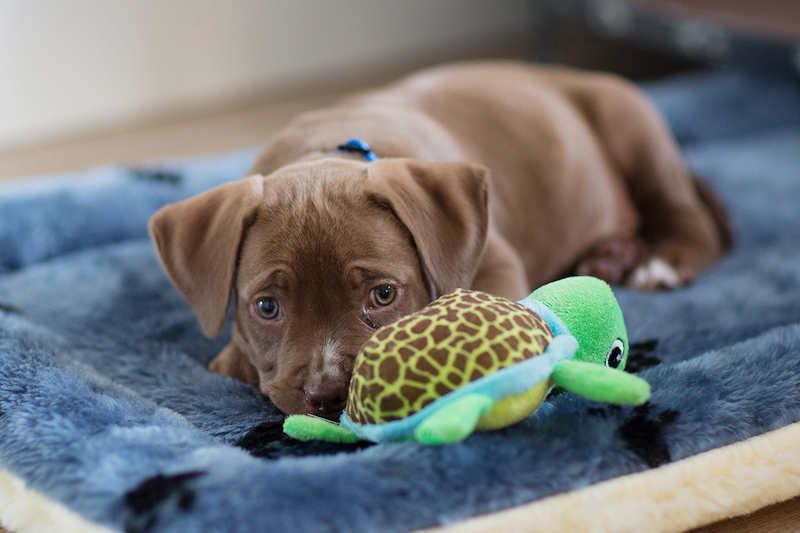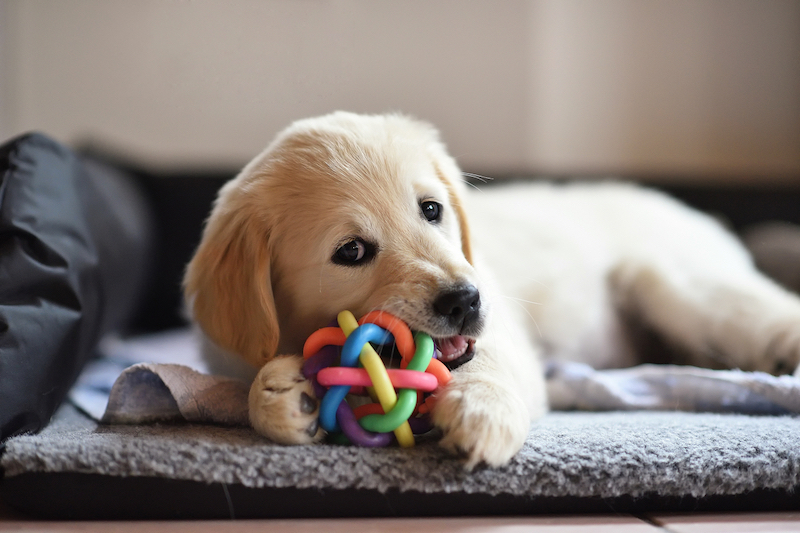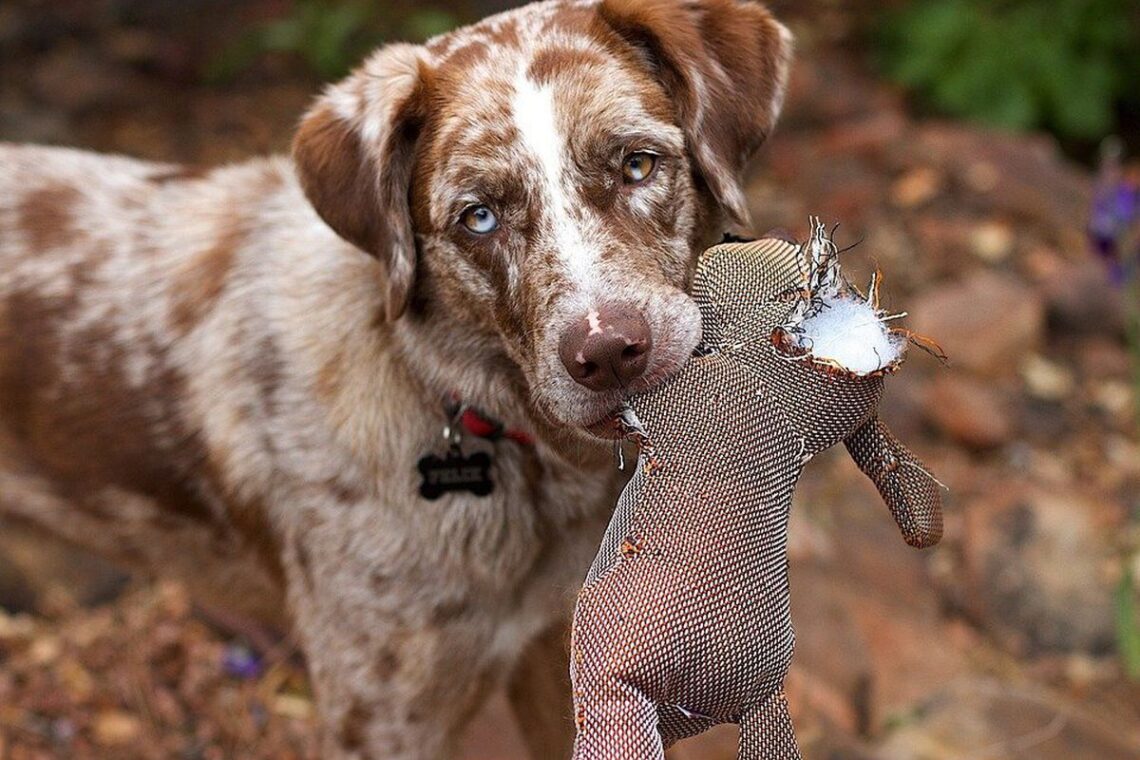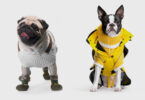Spoiling your dog is as much fun for you as it is for him. But before ordering a new dog accessory online or going together to pick out a new chew toy at a pet store, you must remain vigilant: some toxic and harmful products contained in these objects can be dangerous.
This is because the following chemicals can be found in common products for pets, especially dog and cat toys and dog baskets.
List of toxic products found in toys and accessories for dogs and cats
- Polyvinyl chloride (PVC)
PVC, more commonly known as vinyl, is sometimes used to make dog toys. As such, PVC is not dangerous, but it is a very hard material. In order to make toys softer and more flexible for dogs to play with and chew on, manufacturers add phthalates, toxic chemicals, to them. Plus, PVC contains chlorine, and when dogs chew on PVC toys, they end up releasing chlorine over time.
Why is this dangerous?
Chlorine produces dioxins, which are dangerous pollutants. They are notoriously carcinogenic and seriously affect the immune system of animals. Dioxins are also associated with reproductive and developmental problems, so it is especially important to avoid giving vinyl toys to growing puppies and kittens.
- Phthalates
As mentioned above, phthalates are toxic chemical compounds. They are the additive that makes PVC toys flexible, which makes dogs chew on them. Phthalates smell like vinyl. Do you know that particularly distinct smell? The more PVC dog toys give off this smell, the more phthalates they contain. And so, the more toxic the smell.
Why are they dangerous?
The more your dog chews or plays with vinyl, the more phthalates are released. These toxins travel freely and can be absorbed through your dog’s gums or skin, damaging his liver and kidneys.
- Bisphenol A (BPA)
BPA is all around us. This chemical is used in the manufacture of polycarbonate plastic, which can be found in plastic bottles, cosmetic packaging, receipts, or car parts. The most important thing to know to take care of your dog’s health is that BPA can be found on the coating of their canned food.
Why is this dangerous?
A study has shown that BPA disrupts the canine endocrine system. It can for example cause disturbances in the dog’s metabolism.
- Lead
Lead is a well-known toxin. Since lead paint was not banned until the 1970s, it is still possible for dogs and cats to come into contact with, lick or ingest lead paint chips. Other potential sources of lead include:
- Golf balls
- Imported tennis balls made especially for pets
- Imported dog toys (the keyword here is “imported”)
- Ceramic bowls for water or food that have not been properly glazed
- Water contaminated with lead
Why is this dangerous?
Puppies and kittens are the most vulnerable to lead poisoning. But any animal in contact with lead is susceptible to poisoning. Lead can damage many organs, as well as the nervous system and digestive tract.

Here are some signs of lead poisoning to look out for in your dog or cat:
- Lack of appetite
- Vomiting
- Diarrhea
- Constipation
- Hysteria and anxiety, which can manifest as hysterical barking in dogs
- Bruxism of the jaw (fast tightening of the teeth)
- Salivation
- Blindness
- Crises
- Lack of coordination
- Muscle spasms
- Chromium
Chromium, in trace amounts, is an essential trace element in the body. Chromium deficiency leads to insulin resistance and symptoms similar to those of diabetes. Vets sometimes use it in microdoses as a supplement to insulin for dogs. However, high levels of chromium in the body can be toxic.
Toys and accessories for dogs and cats made in China and sold in supermarkets can contain many toxic substances, including heavy metals such as chromium, as revealed by an investigation by the European Chemicals Agency. on toys. The investigation focused on toys for children, but it seems clear that toys for dogs and cats are no exception.
Why is this dangerous?
Chromium is known to be carcinogenic. It can also have unwanted effects on the respiratory, gastrointestinal, and immune systems, liver, and kidneys.
- Formaldehyde
Bones, sticks, and chews often contain formaldehyde, which is used for preservation purposes.
Why is this dangerous?
If your dog chews too much of these formaldehyde-containing chews, or for too long, it can cause irritation to the respiratory system or digestive system. According to the International Agency for Research on Cancer, any type of exposure to formaldehyde (whether inhaled, ingested, or absorbed through the skin) can cause cancer.
- Cadmium
The same European study carried out on toys imported from China which revealed high levels of chromium also highlighted the presence of high levels of cadmium, a heavy metal known for its dangerousness.
Why is this dangerous?
Cadmium destroys the joints, kidneys, and lungs.
- Bromine
Bromine is used for its flame retardant (flame retardant) properties. These flame retardants are most commonly found in foam upholstery in furniture, including dog cushions. An American study by the EcologyCenter association detected bromine in several dog cushions.
Why is this dangerous?
Too much bromine in your pet’s body can cause stomach pain, vomiting, constipation, loss of appetite, pancreatitis, muscle spasms, and tremors.
How to avoid toxic products in accessories for dogs and cats?
There are several ways to check for toxic substances in items and accessories that you have already purchased for your pet, and in those that you plan to purchase for them. You can also opt for guaranteed safe accessories and treats purchased from certain manufacturers.

How to keep your dog and cat safe
The Yuka app allows you to decipher the labels of food or cosmetic products to find out if they contain toxic or harmful substances, for us and for dogs.
Choose manufacturers of products and accessories for dogs and cats guaranteed without toxic products
Some pet companies have much higher ethical and safety standards than others and are committed to the quality and reliability of their products. Be careful, however: it is not enough for the word “natural” to be written on a product to guarantee its safety. Instead, look for specific specifications such as “BPA free” or “organic” (a term subject to very strict and independent certification) to make sure these products are safe.
- Beco Pets is a UK company specializing in ecological, ethical, and healthy dog and cat food and accessories. For example, they offer bamboo bowls in several sizes.
- The famous KONG toy is known to be made of natural rubber.
- The brands sell online pet products that are organic, ethical, elegant, and comfortable, such as this high-end pillow available in several sizes. They also have a large selection of furniture and travel accessories for dogs and cats.
- You will also find many toys for cats and dogs in natural materials (cotton, wood…) online such as a wooden stimulation toy for dogs, available in two sizes and guaranteed to be free of plastic and toxic substances.
Homemade toys are another great way to ensure that your pet is not exposed to any toxic or harmful products. If that sounds like you, why not try these do-it-yourself dog toys?
Don’t hesitate to look for statements from companies about the safety standards they apply, on labels, and on their websites. When in doubt, calling or emailing the company in question is the safest way to learn about the materials they use.
When it comes to our animals, we can never be too careful. But don’t forget to have fun, too!







